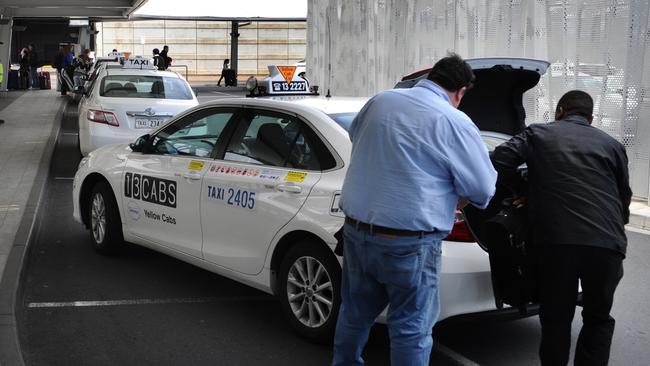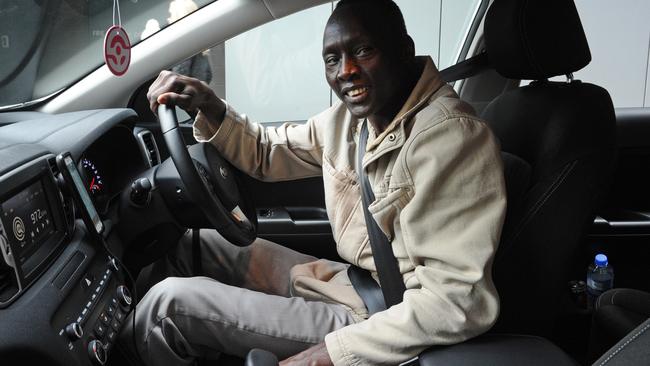Taxis and Uber go head-to-head in a battle for your buck
UBER users swear by the ride-sharing service, while cabbies claim its ruining their livelihood. NATHAN DAVIES took a few rides to get the word from the drivers

UBER users tend to swear by the ride-sharing app.
They claim it’s cheaper and more convenient, that the cars tend to be newer and cleaner and that the drivers — who are subject to star ratings from their customers — are often friendlier.
For cabbies, however, the introduction of Uber has been a disaster, putting serious dents in their weekly takings and radically reducing the value of their taxi licences.
When the Adelaide Airport allowed Uber to collect customers from Adelaide Airport earlier this month many of the cabbies went on strike, refusing to pick up passengers.
They say the playing field is uneven. The Uber drivers say the cabbies should have seen the writing on the wall and adapted to the change.
I spent the day riding in cabs and Ubers to get a handle on the argument.
Both services had their pros and cons, but all the drivers had one thing in common — they were hardworking blokes just trying to make a buck in an increasingly crowded and complicated industry.
8.56am, MELROSE PARK TO CITY, UBER (BMW 5 Series)
Wait time: four minutes
COST: $20.84
NEW to the whole Uber experience, I walked out into my driveway and punched my destination into the app.
It told me that my driver John was four minutes away, and I followed the car icon on the app’s map as it made its way to my house.
Exactly four minutes later a gleaming, late-model 5 Series BMW quietly rolled to stop in front of my house. I think I could get used to this.
John is semi-retired, and recently moved to Adelaide from Sydney for a more relaxed lifestyle. He says the best thing about driving Uber is the flexibility. He works when he wants to and has a day off when he feels like it. He avoids Hindley St like the plague.
“This car doesn’t go down Hindley St, and I don’t work on Friday or Saturday nights,” the affable 65-year-old says. “I would do about 25 trips a week, and that makes me about $325 to $350.”
While he says he does have some sympathy for cabbies who have seen both their fares and the value of their plates plummet since the introduction of Uber service, he believes they should have seen the writing on the wall.
“The cab industry is not the only industry going through change,” he says.
“Welcome to the real world. In ten years’ time I could be replaced by a driverless car.”
He says driving Uber was a perfect job for anyone looking for a flexibility and an income top-up. “I’m a happy camper,” he says. “This is good for me, and it’s good for the consumer.”

10.46am, WAYMOUTH ST TO AIRPORT, TAXI (TOYOTA COROLLA) WAIT TIME: 30 SECONDS
COST: $19.30
RATHER than an app, this time I use the old-fashioned “stick your hand out” technique.
The Corolla is a step down from the BMW, but while it might be a bit worn on the inside it’s clean and tidy and driver Mandeep is happy to talk about the impact Uber has had on his job.
“We have to work more hours for less money,” he says. “We’re definitely feeling it.” Mandeep says that before Uber arrived in Adelaide he could make $500 on a busy Friday or Saturday night.
Now he makes less than $300, and that’s before the licence owner takes a cut. In an average week Mandeep says he can work up to 70 hours a week for between $650 and $700 take-home pay — about $200 a week less than he earned before the ride-sharing app arrived on the scene.
“I really think the Government should have organised things better before they allowed Uber into the market,” he says.
“They either need to bring Uber up to the same level of compliance that we’re at, or let taxis operate at their level. At the moment it’s just not a fair playing field.”
Mandeep says he planned to leave the taxi industry and was currently working towards gaining his heavy-vehicle licence so he can drive trucks for a living.
“I feel sorry for the people who paid $400,000 for a taxi plate that’s now worth $50,000, and only going to go lower,” he says.

11.32am, AIRPORT TO WAYMOUTH ST, UBER
(KIA SPORTAGE)
WAIT TIME: FOUR MINUTES
COST: $19.57
I WALK to the Adelaide Airport’s new “ride share” rank where there were a bunch of young blokes from Melbourne in front of me.
“Why is Uber better than taxis?” I ask them.
“It’s cheaper, more convenient and the cars are better,” one replies as they pile into the shiny sedan that’s arrived to pick them up.
After a four-minute wait my driver Deng arrives in a Kia that he rents on a weekly basis so he can work as a driver. It’s his first week driving Uber full-time after a three-month stint as a part-time driver. For the 44-year-old father of four from South Sudan it beats his old job in a chicken-processing factory.
“If I have a good week I’ll make about $800,” Deng says. “It’s a good job and I get to talk to lots of different people. It’s like getting free English lessons.”
Deng says he preferred the Uber model to driving a traditional cab for the flexibility it offered, and the fact that no physical cash ever changes hands.
“Nobody can run off without paying or complain about a fare,” he says.
“And you’re not a target for a robbery because there’s no money in your car.”
Deng, like John, says he can understand why cabbies feel that Uber is muscling in on their territory.
“But once upon a time we were all watching black and white TVs, now we’re watching digital flat-screens. Things change.”

6.25pm, WAYMOUTH ST TO MELROSE PARK
TAXI (TOYOTA PRIUS)
WAIT TIME: ZERO
COST: $23.43
I’M riding home in a well maintained Prius with Sam, who tells me that it’s Friday and Saturday nights — the traditional gravy train nights for divers — that have been hit most hard by Uber.
“I reckon most drivers would be $300 down over those two nights, and probably $400 down across the whole week,” he says.
Sam, a cook who drives a few shifts to top up his income, says he thinks the government has an obligation to protect South Australian businesses. “You have to look after your local industries,” he says. “The taxi companies are paying tax here in the state, but Uber is an American company so who knows where that money eventually ends up.”
Sam says he feels safer driving a traditional taxi because of the fitted security cameras.
“This is safer for me, and it’s also safer for the customer,” he says.
